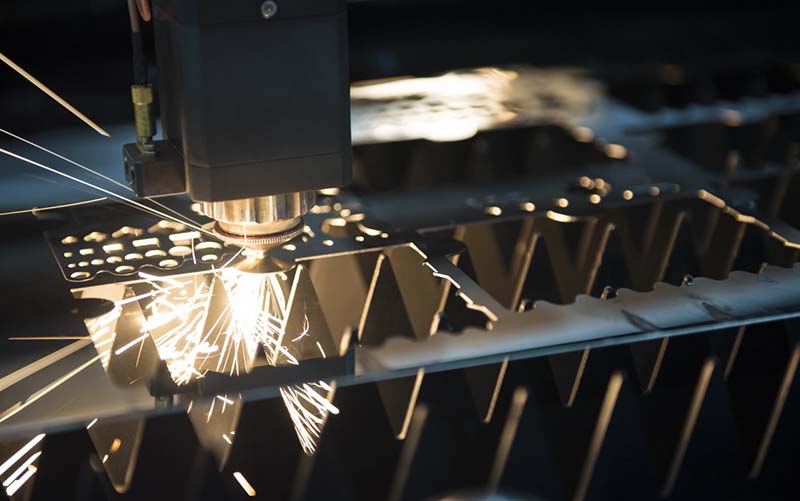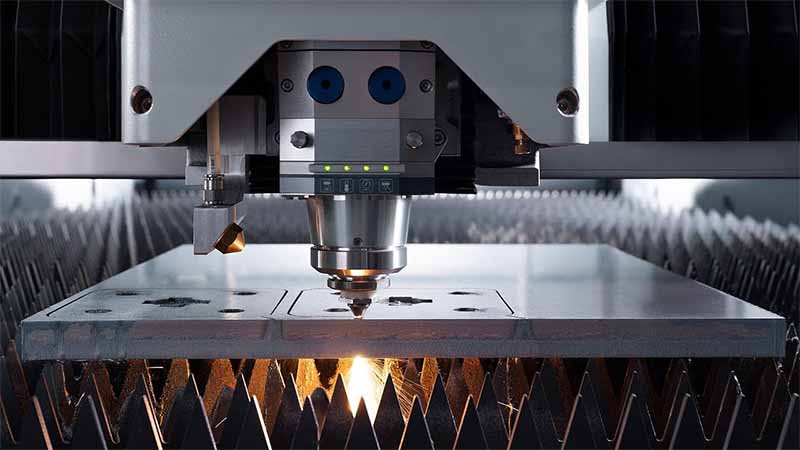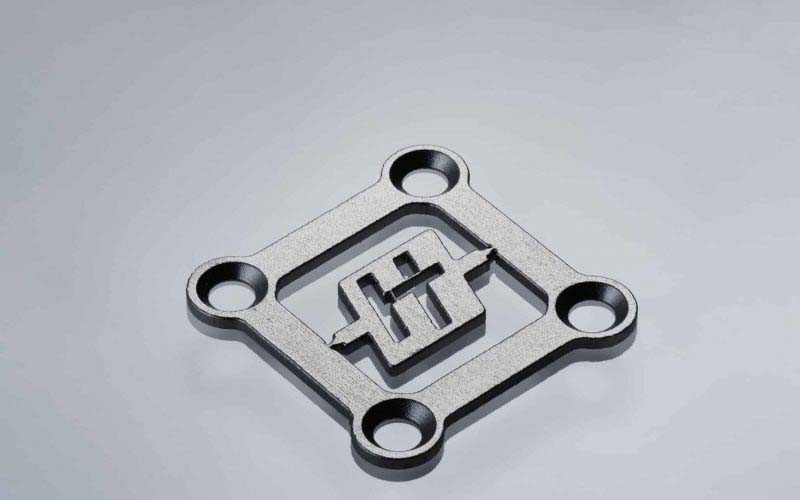As an advanced metal processing method, laser cutting utilizes a high energy density laser beam to melt or vaporize the material, which has the remarkable features of high speed, high precision, high quality and high efficiency. Laser cutting is an efficient and high-precision cutting method that is widely used for stainless steel sheets of various thicknesses. Laser cut stainless steel sheet is widely used in many fields such as construction, decoration, machinery, kitchen utensils and so on.
Applications of Metal Laser Cutting Machine on Stainless Steel
Laser cutting stainless steel has a wide range of applications, covering many fields such as machinery manufacturing, construction and decoration, home appliance manufacturing and metal processing.
Precision Cutting for Medical Industry
Medical device manufacturing has extremely high requirements for the precision and quality of components, and s laser cutting machine for stainless steel is an ideal for meeting these needs. Medical devices often require complex piping and connecting structures, and laser cutting technology enables high-precision, loss-free cutting of tubes of different materials and shapes.
Automotive Industry
In automobile manufacturing, stainless steel laser cutting machine is widely used. Automobile parts usually require complex pipes and curved structures, and traditional cutting methods are difficult to meet these needs. Stainless steel laser cutting machines are able to accurately cut a variety of tubes without loss of material quality through precise control of the laser beam. This advanced technology improves the quality and productivity of parts, and excels especially in handling complex stainless steel pipes. Stainless steel laser cutting provides an efficient and precise solution for the automotive manufacturing industry.
Mechanical and Industrial Parts
Laser cut stainless steel ensures high resistance and extremely high manufacturing accuracy of precision parts to tolerances of 0.01 mm. Applications include the manufacture of precision gears, brackets and mounting components, where laser cutting technology guarantees the accuracy of tool profiles and maintains the efficient operation of mechanical systems. While ensuring accurate specifications for metal parts, laser cutting provides a reliable foundation for safe and stable mounting. For rapid prototyping, the best laser cutting stainless steel provides a precise and efficient solution.

Kitchens and Utensils
Laser for cutting stainless steels plays a key role in the kitchenware industry. It meets the high demands for quality and design in kitchenware through efficient and precise cutting solutions. This technology is widely used in the manufacture of knives, enabling precision cutting and engraving of blades, increasing the durability and effectiveness of knives. Meanwhile, laser cutting is used to create kitchenware of all shapes and sizes, ensuring consistency and a beautiful appearance. For pipes and connecting parts, laser cutting stainless steel tubes enables high-precision, loss-free cutting, ensuring precision and reliability of parts. In addition, laser cutting technology provides flexibility for customized designs, allowing manufacturers to easily implement complex customization needs. Most importantly, the highly automated process of laser cutting improves production efficiency, providing kitchenware manufacturers with strong support in responding to high volumes of orders and customization needs.
Laser Stainless Steel Doors and Frames
Laser cut stainless steel is used to achieve precision cutting and engraving of window and door frames, enhancing the visual appeal and durability of windows and doors. This helps to create exquisite and powerful door and window products that meet consumers’ pursuit of high-quality residential decoration. Laser cutting technology is also used to process windows and doors in a variety of shapes and sizes, ensuring a consistent and aesthetically pleasing product appearance.
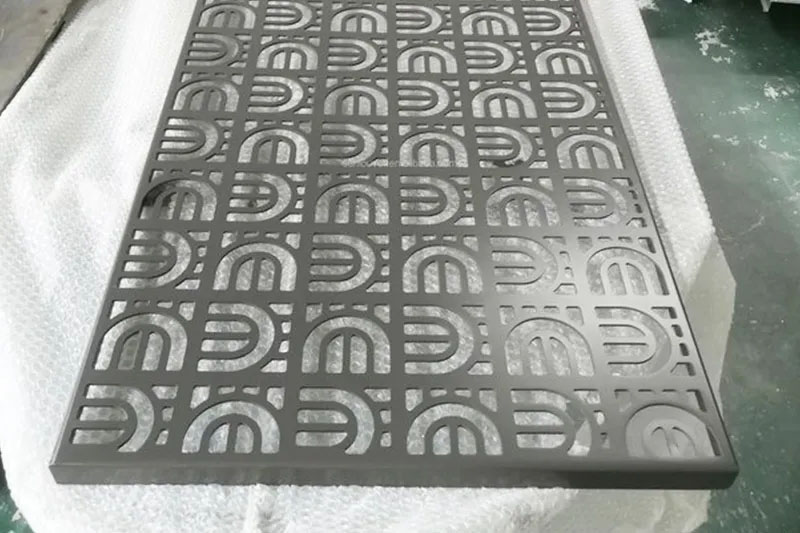
The Advantages of Laser Cutting Stainless Steel
Clean Edges:
One of the significant advantages of laser cutting stainless steel is the clean and burr-free cuts it produces without causing the material to warp, thus significantly improving cut quality and the final product is guaranteed to be flawless.
Low Thermal Impact
Due to the low heat generated during laser cutting, it is particularly suitable for handling tiny parts, avoiding the adverse effects of thermal influences on the part.
No Maintenance
Laser technology in stainless steel cutting does not require frequent maintenance, providing easier operation for routine projects.
High Accuracy
Laser cutting is able to maintain high accuracy when cutting stainless steel, ensuring that the results meet precise requirements.
High Consistency
The laser cutting machine’s stainless steel cutting tolerance is about ±0.001mm, and the repetitive positioning accuracy is about 0.02mm, which ensures that each part has the same high quality standard.
Efficient and Fast
Laser cutting can increase productivity by completing metal cutting projects in the shortest possible time.
The laser cutting technology for stainless steel plate demonstrates a high degree of adaptability to complex shapes and precise cutting of materials. This processing method not only improves the utilization of materials, but also significantly increases the production efficiency. Through laser cutting, stainless steel can be accurately engraved into various shapes to meet the needs of different industries for high-quality and high-precision processing.

How Thick Can a Laser Cut Stainless Steel?
Typically, the thickness of stainless steel sheets ranges from 0.1 mm to 25 mm, and laser cutting machines are perfectly adapted to sheet thicknesses within this range.
In the thinner thickness range, such as between 0.1 mm and 2 mm, laser cutting performs well with high quality cutting edges, avoiding problems of burrs or distortion.
Medium thickness stainless steel plates, between 2 mm and 10 mm, are also suitable for laser cutting, but in this range more attention needs to be paid to the choice of cutting speed and beam quality to ensure a high level of cut quality.
For relatively thick stainless steel sheets, between 10 mm and 25 mm thick, laser cutting is correspondingly more difficult. In this case, higher power and slower cutting speeds are required to overcome the thickness of the material but still achieve high quality cuts.
The efficiency of 500W~6000W fiber laser cutting machines for different thicknesses stainless steel plates in the following table:
| Power | 500W | 800W | 1000W | 1500W | 2000W | 3000W | 4000W | 6000W | |
| Material | Thickness(mm) | Speed(m/min) | Speed(m/min) | Speed(m/min) | Speed(m/min) | Speed(m/min) | Speed(m/min) | Speed(m/min) | Speed(m/min) |
| Stainless steel(N₂) | 1 | 8.0-10.0 | 11.5-13.5 | 14.0-16.0 | 16.0-18.0 | 20.0-28.0 | 20.0-28.0 | 35.0-42.0 | 50.0-70.0 |
| 2 | 2.0-2.5 | 3.2-3.8 | 4.0-5.0 | 5.0-7.0 | 9.0-13.0 | 9.0-13.0 | 15.0-23.0 | 30.0-40.0 | |
| 3 | 1.0-1.5 | 2.0-3.0 | 3.2-4.5 | 4.0-6.5 | 4.0-6.5 | 7.0-11.0 | 17.0-22.0 | ||
| 4 | 1.2-1.6 | 2.0-2.8 | 3.0-4.5 | 3.0-4.5 | 4.0-6.0 | 9.0-14.0 | |||
| 5 | 0.7-1.0 | 1.2-2.0 | 1.4-2.5 | 1.4-2.5 | 2.5-4.0 | 7.0-12.0 | |||
| 6 | 0.7-1.0 | 0.9-1.8 | 0.9-1.8 | 2.0-3.2 | 5.0-8.0 | ||||
| 8 | 1.2-1.8 | 3.8-5.0 | |||||||
| 10 | 0.7-0.9 | 1.6-2.5 | |||||||
| 12 | 1.1-1.8 | ||||||||
| 16 | 0.7-1.2 |
How to Laser Cut Stainless Steel?
Material Preparation
First, prepare the stainless steel sheet by cleaning it to remove any dirt or oil that may interfere with the cutting process.
Machine Setup
Configure the laser cutter according to the type and thickness of the stainless steel. This includes setting the proper power level and cutting speed.
Machine Parameter Settings
To measure the superiority or inferiority of laser cutting stainless steel plate cutting, it is mainly from the roughness, perpendicularity, cutting width, grain, burr, the size of the heat-affected area, and whether it causes deformation of the plate in the cutting and so on to comprehensively judge several aspects. If you want to cut quality stainless steel thick plate workpiece, you need to pay attention to the process and parameters mentioned below.
Nozzle Selection
The choice of nozzle diameter plays a key role in the process of laser cutting stainless steel plate. The size of the nozzle diameter directly affects the shape of the gas flow, gas diffusion area and gas flow rate, thus affecting the removal of molten material and cutting stability. As the thickness of the stainless steel plate increases, the diameter of the nozzle should be increased accordingly, and the proportional valve needs to be set to a larger value in order to increase the gas flow rate and ensure the pressure, so as to realize the normal cutting effect.
The selection of the aperture is related to the power of the laser cutting machine, as the power increases, the heat generated will also increase, so a larger gas volume is required. Generally speaking, when cutting plates below 3mm, choose a nozzle with a 2.0mm orifice; when cutting plates from 3mm to 10mm, choose a 3.0mm nozzle; while cutting plates above 10mm requires the use of a nozzle of 3.5mm and above.
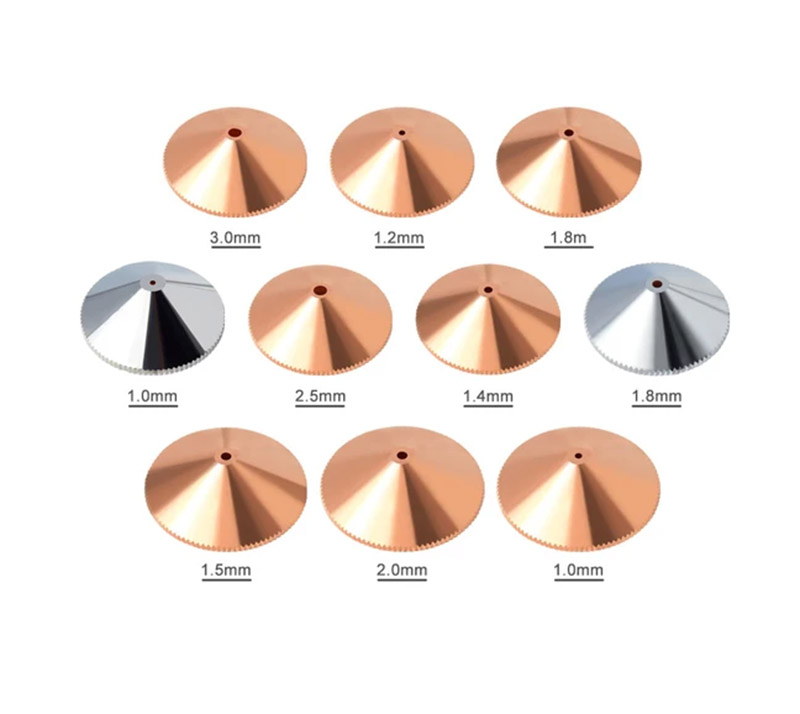
Auxiliary Gas Selection and Gas Purity
In stainless steel laser cutting, a variety of auxiliary gases are commonly used, such as oxygen, nitrogen, air and so on. Different gas types will affect the effect of the cut section, and nitrogen is the preferred auxiliary gas for stainless steel cutting. Nitrogen can effectively maintain the original color of stainless steel and prevent oxidation, thus avoiding the need for rework of the workpiece. It is recommended to use nitrogen with purity≥99.995%. Roc Laser’s self-developed nitrogen generator can stably produce nitrogen gas with purity greater than 99.99%, which is suitable for laser welding and laser cutting of various metal materials.
Focus Position
The position of the focal point has an important impact on the thickness, material and quality of the cut. Depending on the material and thickness of the cut, the focus position needs to be adjusted. In stainless steel cutting, negative out-of-focus is predominant, and the cutting process parameters are tested and analyzed by measuring the zero focus and using it as a reference.
Zero Focus: The laser focus is on the surface of the cut workpiece, suitable for thin carbon copper below 1mm, etc. The upper surface is cut smooth, while the lower surface is not smooth.
Negative focal length: The laser focus is below the surface of the cut workpiece, stainless steel cutting method, the focus is below the plate surface, so the range of smooth surface is larger, the slit is wider than the zero focal length slit, the gas flow is larger when cutting, and the perforation time is longer than the zero focal length. The deeper the focal point, the larger the laser cut slit on the plate surface. The larger the cut slit, the more the laser energy is dispersed, which leads to slower and slower speed.
Positive focal length: the laser focus is above the surface of the cut workpiece, used when cutting carbon steel with oxygen, the surface is blackened and the section is rougher.
Laser Frequency Adjustment
By adjusting the laser frequency, the cutting section effect can be improved. By lowering the frequency to the range of 500-1000Hz, the cut section becomes more delicate and the delamination improves. In order to ensure an optimal cut section, it is necessary to ensure that the number of pulses is perfectly matched to the energy of a single pulse.
Pulse Duty Cycle
The pulse duty cycle is an important parameter that influences the cutting effect. When the pulse duty cycle is lower than 45%, the lower surface may show traces of undercutting; and when the duty cycle is increased to 60%, the section becomes rough, the delamination is obvious, and the cutting surface may be yellowed. Therefore, it is necessary to find the optimal pulse duty cycle range around the 45% critical value to ensure the best cutting effect.
In addition to the above parameters, there are some other parameters will also affect the effect of laser cutting stainless steel, such as the laser beam diameter, scanning speed, scanning distance and so on. In practical application, according to the thickness, shape, hardness and other factors of the cutting material need to be considered comprehensively, in order to achieve the best cutting effect.
Cutting Process
Start the cutting process. The laser beam will follow the path defined in the digital design to cut the stainless steel plate.
Post-cutting Operation
After cutting, the cut stainless steel edges may need to be cleaned or remove burrs.
Why Choose DP LASER CNC Laser Cutting Machine for Stainless Steel?
Our laser cutting equipment is affordable, thanks to our multiple manufacturing facilities in China, which reduces production costs. Secondly, we have a strong design team, including over 300 engineers, who are constantly pushing the boundaries of innovation to ensure that our laser cutting equipment remains at the forefront of the industry.
To meet the needs of different manufacturing companies, our fiber laser cutting machine can be customized to meet specific customer requirements. This flexibility allows our equipment to be adapted to the different production needs of a wide range of industries, making it the preferred choice of manufacturing companies of all sizes.
Multiple divisions around the world provide us with the ability to respond more quickly to meet the after-sales needs of our overseas customers and provide on-site training services. Helping our customers to better utilize their laser equipment ensures that they are able to take full advantage of their laser equipment and improve productivity.
In addition to affordability and customization, we are constantly working to refine and optimize our equipment to ensure that it always performs at its best.

With laser technology, we have not only improved the precision and efficiency of cutting, but also realized a more flexible design and production process. Stainless steel, as a common and important material, plays a key role in a variety of industries, and the development of laser cutting technology has opened up entirely new possibilities for its processing. As technology continues to advance, we can expect laser cutting machine for stainless steel to continue to play a more important role in the field of stainless steel processing.

